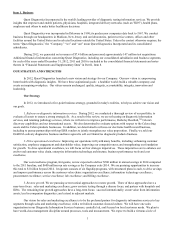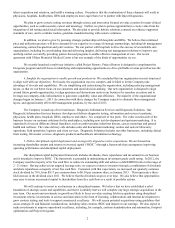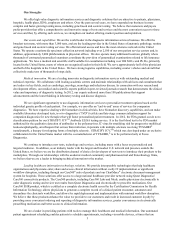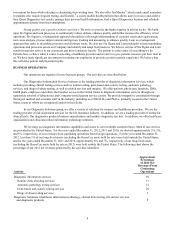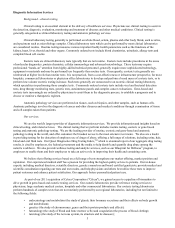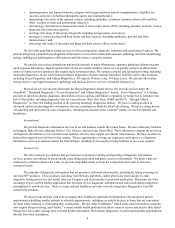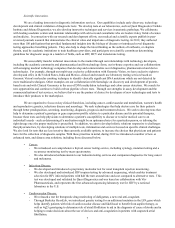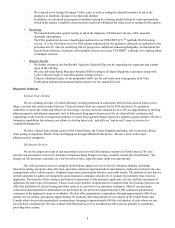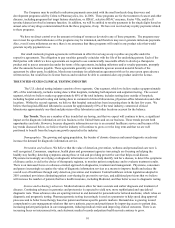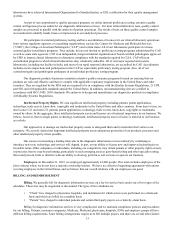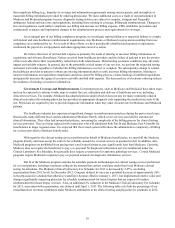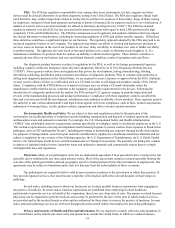Quest Diagnostics 2012 Annual Report Download - page 13
Download and view the complete annual report
Please find page 13 of the 2012 Quest Diagnostics annual report below. You can navigate through the pages in the report by either clicking on the pages listed below, or by using the keyword search tool below to find specific information within the annual report.10
The Company may be entitled to milestone payments associated with the small molecule drug discovery and
development programs sold by Celera to Pharmacyclics, Inc. in 2006. These programs are for the treatment of cancer and other
diseases, including programs that target histone deactylase, or HDAC, selective HDAC enzymes, Factor VIIa, and B cell
tyrosine kinases involved in immune function. In addition, we will be entitled to royalty payments in the single digits based on
annual sales of any drugs commercialized from the three programs, if any. We have not received any royalty payments related
to these programs.
We have no direct control over the amount or timing of resources devoted to any of these programs. The programs may
never meet the specified milestones or the programs may be terminated, and therefore may never generate milestone payments.
Also, even if some milestones are met, there is no assurance that these programs will result in any product sales that would
generate royalty payments to us.
Our small molecule program agreements will remain in effect for as long as any royalties are payable under the
respective agreements. The obligation to pay royalties generally coincides with the life of the underlying patents. Each of the
third parties with which we have agreements are required to use commercially reasonable efforts to develop a therapeutic
product and to pay us amounts due under the terms of the agreements, including milestone and/or royalty payments, promptly
after the amounts become payable. These agreements generally are terminable upon an uncured material breach of the
agreement by either party. In addition, Merck may terminate its collaboration agreement with us for any reason upon advance
written notice, but would lose its license from us and would not be able to commercialize any product under the license.
THE UNITED STATES CLINICAL TESTING INDUSTRY
The U.S. clinical testing industry consists of two segments. One segment, which we believe makes up approximately
40% of the total industry, includes testing done within hospitals, including both inpatient and outpatient testing. The second
segment, which we believe makes up approximately 60% of the total industry, includes testing done outside of hospitals,
including hospital outreach testing and testing done in commercial clinical laboratories, physician-office laboratories and other
locations. Within the second segment, we believe that hospital outreach has been increasing share in the last few years. We
believe that hospital-affiliated laboratories account for approximately 60% of the total industry, commercial clinical
laboratories approximately one-third and physician-office laboratories and other locations account for the balance.
Key Trends. There are a number of key trends that are having, and that we expect will continue to have, a significant
impact on the diagnostic information services business in the United States and on our business. These trends present both
opportunities and risks. However, because diagnostic information service is an essential healthcare service and because of the
key trends discussed below, we believe that the industry will continue to grow over the long term and that we are well
positioned to benefit from the long-term growth expected in the industry.
Demographics. The growing and aging population, the burden of chronic diseases and unmet diagnostic needs may
increase the demand for diagnostic information service.
Prevention and wellness. We believe that the value of detection, prevention, wellness and personalized care now is
well recognized. Consumers, employers, health plans and government agencies increasingly are focusing on helping the
healthy stay healthy, detecting symptoms among those at risk and providing preventive care that helps avoid disease.
Physicians increasingly are relying on diagnostic information services to help identify risk for a disease, to detect the symptoms
of disease earlier, to aid in the choice of therapeutic regimen, to monitor patient compliance and to evaluate treatment results.
There is an increased focus on a disease-oriented approach to diagnostics, treatment and management. Physicians, consumers
and payers increasingly recognize the value of diagnostic information services as a means to improve health and reduce the
overall cost of healthcare through early detection, prevention and treatment. Federal healthcare reform legislation adopted in
2010 contained provisions eliminating patient cost-sharing for preventive services, and additional provisions that we believe
will increase the number of patients that have health insurance, including Medicaid, and thus better access to diagnostic testing.
Science and technology advances. Medical advances allow for more accurate and earlier diagnosis and treatment of
diseases. Continuing advances in genomics and proteomics is expected to yield new, more sophisticated and specialized
diagnostic tests. These advances also are spurring interest in and demand for personalized or tailored medicine, which relies on
diagnostic and prognostic testing. Pharmacogenomic testing increasingly is used as a parameter to help speed drug approval
processes and to better focus therapy based on patient and tumor-specific genetic markers. Demand also is growing toward
comprehensive care management solutions that serve patients, payers and practitioners by improving access to patient data,
increasing patient participation in care management, reducing medical errors and improving clinical outcomes. There is an
increasing focus on interconnectivity, and electronic medical records and patient health records continue to grow.



